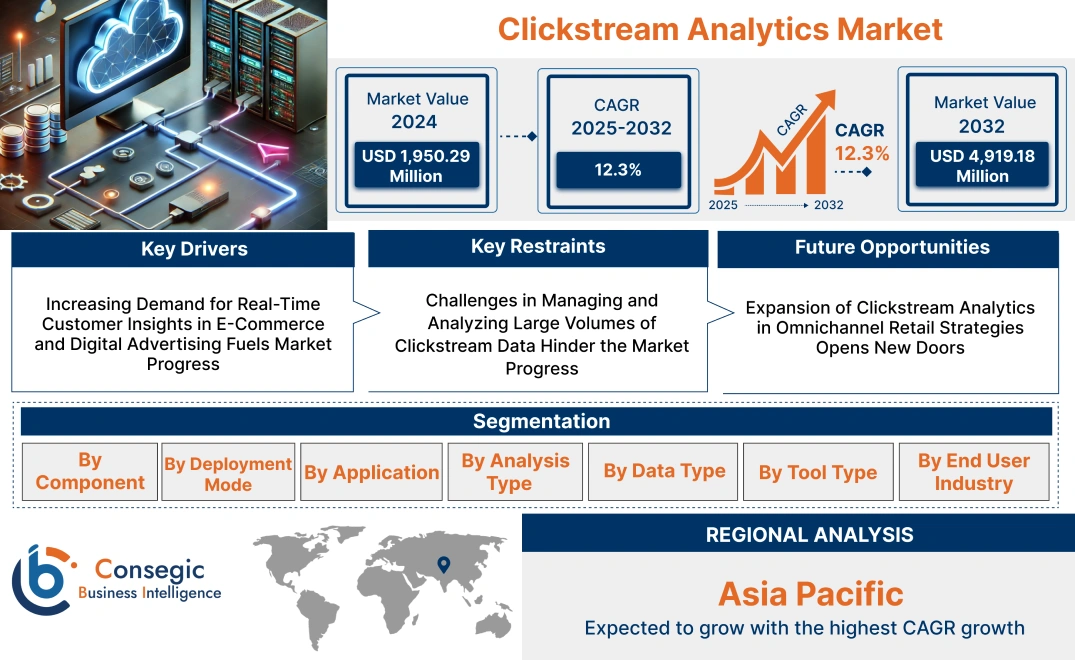- Summary
- Table Of Content
- Methodology
Clickstream Analytics Market Size:
Clickstream Analytics Market size is estimated to reach over USD 4,919.18 Million by 2032 from a value of USD 1,950.29 Million in 2024 and is projected to grow by USD 2,154.65 Million in 2025, growing at a CAGR of 12.3% from 2025 to 2032.
Clickstream Analytics Market Scope & Overview:
Clickstream analytics involves the process of collecting, analyzing, and interpreting data generated by users' interactions on websites and digital platforms. This technology tracks the sequence of clicks or navigation patterns, providing valuable insights into user behavior, preferences, and engagement levels. By leveraging clickstream data, organizations optimize website performance, enhance user experiences, and make data-driven decisions to improve conversion rates and customer retention. The solutions typically include tools for data collection, visualization, real-time analysis, and reporting.
Businesses are increasingly adopting these solutions to gain deeper insights into customer journeys, enhance personalized marketing strategies, and increase online sales. With advancements in big data analytics and artificial intelligence, clickstream analytics has become a critical tool for organizations aiming to optimize digital experiences and gain a competitive edge. Key end-users include e-commerce companies, digital marketing agencies, financial services, and media and entertainment providers. As the focus on customer experience and digital optimization intensifies, the market is expected to expand, driven by the need for actionable insights and enhanced decision-making capabilities.
Clickstream Analytics Market Dynamics - (DRO) :
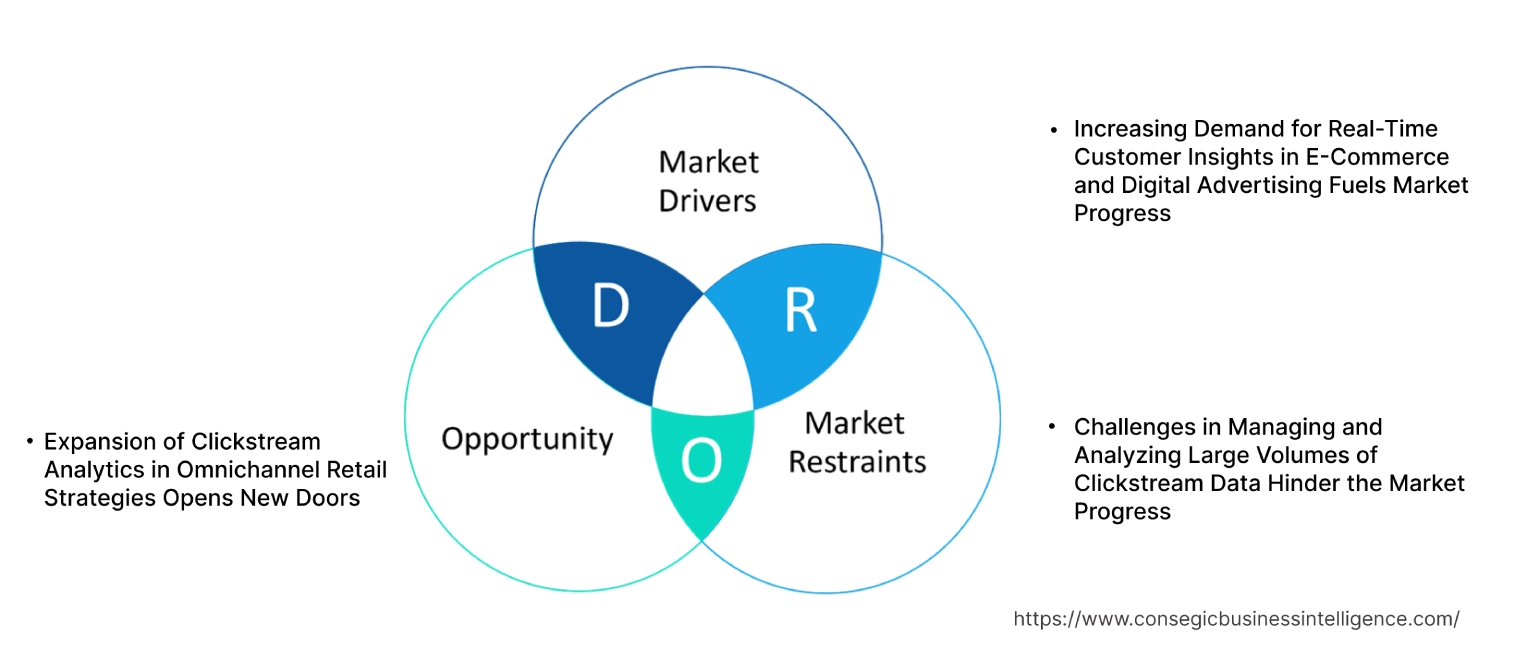
Key Drivers:
Increasing Demand for Real-Time Customer Insights in E-Commerce and Digital Advertising Fuels Market Progress
The growing emphasis on real-time customer insights is a significant driver for the clickstream analytics market, especially in e-commerce and digital advertising. As online retailers and advertisers aim to enhance user engagement and boost conversion rates, they require detailed, actionable insights into customer behavior patterns. Clickstream analytics provides a granular view of users' online activities, including page visits, navigation paths, and time spent on specific pages. This data enables businesses to understand customer intent, optimize website content, and personalize marketing campaigns in real time. The shift towards interactive advertising and dynamic content personalization, where decisions are made instantly based on user behavior, is further accelerating the adoption of clickstream analytics solutions. Companies that leverage real-time clickstream data to deliver targeted experiences are better positioned to drive higher engagement and increase sales. Thus, the aforementioned factors further drive the clickstream analytics market growth.
Key Restraints :
Challenges in Managing and Analyzing Large Volumes of Clickstream Data Hinder the Market Progress
One of the major restraints in the clickstream analytics market is the complexity of managing and analyzing large volumes of clickstream data, particularly in high-traffic digital environments. Clickstream data is generated continuously as users interact with websites and digital platforms, resulting in massive datasets that require advanced storage, processing, and analytical capabilities. The sheer volume and velocity of this data make it difficult for businesses to efficiently collect, cleanse, and analyze it in real time. Furthermore, clickstream data is often unstructured, comprising a mix of user actions, device information, and session metadata, which complicates the process of extracting meaningful insights. The need for robust data infrastructure and scalable analytics solutions is a significant barrier for companies, particularly small and medium-sized enterprises (SMEs), limiting their ability to fully capitalize on clickstream analytics. Thus, the above-mentioned factors impact the clickstream analytics market demand.
Future Opportunities :
Expansion of Clickstream Analytics in Omnichannel Retail Strategies Opens New Doors
The growing focus on omnichannel retail strategies presents a substantial opportunity for the clickstream analytics market. Retailers are increasingly seeking to provide a seamless shopping experience across online and offline channels, integrating data from websites, mobile apps, social media, and physical stores. Clickstream analytics plays a crucial role in understanding customer journeys across these touchpoints, offering insights into user preferences, purchasing behavior, and channel interactions. By analyzing clickstream data alongside in-store purchase data, retailers create more cohesive, personalized shopping experiences and optimize their marketing strategies. The need for unified, omnichannel analytics capabilities is driving investment in advanced clickstream analytics solutions that integrate data from multiple sources, helping retailers enhance customer engagement and loyalty. Therefore, the expansion of clickstream analytics in retail fuels the clickstream analytics market opportunities.
Clickstream Analytics Market Segmental Analysis :
By Component:
Based on components, the market is segmented into software and services.
The software segment accounted for the largest revenue of the total clickstream analytics market share in 2024.
- Clickstream analytics software provides tools for collecting, processing, and analyzing user click data to generate actionable insights.
- Advanced software solutions offer features such as real-time analytics, data visualization, and machine learning algorithms, enhancing decision-making capabilities for businesses.
- The increasing requirement for comprehensive data analytics tools that handle large volumes of user interaction data is driving the progress of the software segment.
- Leading software platforms integrate seamlessly with existing digital marketing and CRM tools, providing a holistic view of user behavior across multiple channels.
- As per clickstream analytics market analysis, the software segment leads the market due to its essential role in providing the core analytical capabilities required for in-depth clickstream analysis.As per clickstream analytics market analysis, the software segment leads the market due to its essential role in providing the core analytical capabilities required for in-depth clickstream analysis.
The services segment is anticipated to register the fastest CAGR during the forecast period.
- The services segment includes consulting, implementation, and support & maintenance services that help businesses effectively utilize clickstream analytics software.
- Consulting services assist organizations in identifying key metrics and developing customized analytics strategies tailored to their business needs.
- Implementation services focus on the deployment and integration of analytics software with existing IT infrastructure, ensuring smooth operation.
- Ongoing support & maintenance services provide troubleshooting, updates, and performance optimization, helping organizations maintain efficient analytics operations.
- As per clickstream analytics market trends, the services segment is expected to grow rapidly, driven by the increasing complexity of analytics solutions and the need for expert guidance in implementing and managing these tools.
By Deployment Mode:
Based on deployment mode, the market is bifurcated into on-premise, cloud-based, and hybrid.
The cloud-based segment accounted for the largest revenue share of 58.39% in 2024.
- Cloud-based clickstream analytics solutions offer scalability, flexibility, and ease of access, making them popular among organizations of all sizes.
- The growing adoption of cloud computing and the increasing preference for Software-as-a-Service (SaaS) models are driving the demand for cloud-based analytics solutions.
- Cloud-based platforms provide real-time processing capabilities, allowing businesses to analyze user behavior and make data-driven decisions quickly.
- The lower upfront costs and reduced infrastructure requirements of cloud-based solutions are attractive to SMEs, contributing to the segment's strong growth.
- Cloud-based deployment leads the market due to its scalability, ease of implementation, and ability to support real-time analytics.
- Therefore, as per segmental trends analysis, the cloud-based segment drives the clickstream analytics market expansion.
The hybrid deployment segment is anticipated to register the fastest CAGR during the forecast period.
- Hybrid deployment combines on-premise and cloud-based solutions, offering organizations the flexibility to manage sensitive data on-premise while leveraging cloud resources for scalable analytics.
- This approach is particularly popular among large enterprises that need to balance data security with the benefits of cloud scalability.
- The increasing adoption of multi-cloud strategies and the need for integrated, flexible analytics solutions are driving the growth of hybrid deployments.
- Hybrid models allow organizations to maintain control over critical data while taking advantage of the cost-efficiency and flexibility of cloud services.
- As per segmental trends analysis, the hybrid deployment segment is expected to grow rapidly due to its ability to provide a balanced solution for organizations with complex data management needs.
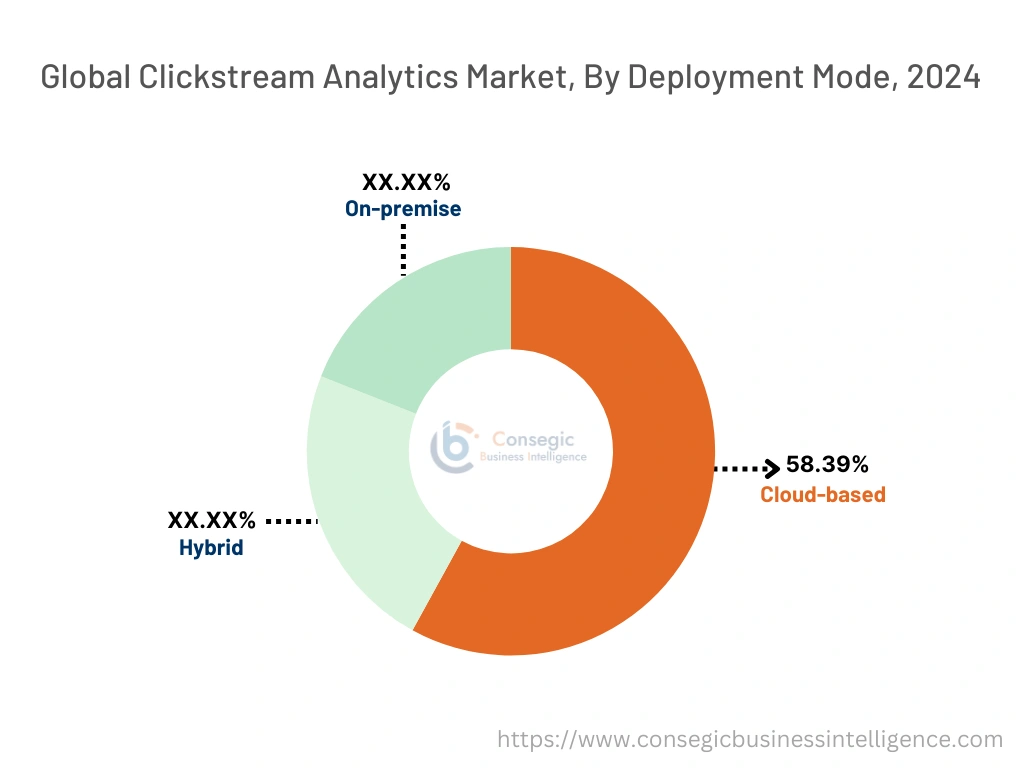
By Application:
Based on application, the market is segmented into traffic analysis, customer engagement, click path optimization, basket analysis, and personalization & targeting.
The personalization & targeting segment accounted for the largest revenue share in 2024.
- Personalization & targeting applications use clickstream data to deliver tailored content and marketing messages based on user behavior.
- The increasing need for personalized user experiences in e-commerce, media, and entertainment drives the adoption of advanced clickstream analytics tools.
- Businesses use these insights to optimize marketing campaigns, improve conversion rates, and enhance customer satisfaction.
- Advanced analytics platforms leverage AI and machine learning algorithms to predict user preferences and behavior, enabling highly targeted marketing efforts.
- As per segmental trends analysis, the personalization & targeting segment leads the market due to the growing importance of delivering customized experiences to drive customer loyalty and engagement.
The click path optimization segment is anticipated to register the fastest CAGR during the forecast period.
- Click path optimization involves analyzing user navigation patterns on websites and apps to identify and resolve issues affecting user experience and conversion rates.
- Businesses use click path analysis to streamline user journeys, reduce bounce rates, and increase the likelihood of successful conversions.
- The increasing focus on enhancing user experience and the need for data-driven optimization strategies are driving the demand for click path optimization tools.
- Advanced clickstream analytics platforms offer visualizations such as heatmaps and session replays, helping businesses understand user behavior in detail.
- As per analysis of segmental trends that click path optimization is expected to grow rapidly due to its critical role in improving website performance and boosting conversion rates.
By Analysis Type:
Based on analysis type, the market is segmented into path analysis, funnel analysis, heatmap analysis, session replays, and A/B testing.
The funnel analysis segment accounted for the largest revenue share in 2024.
- Funnel analysis helps businesses understand the user journey by tracking how visitors move through different stages of a sales or conversion funnel.
- This analysis type is crucial for identifying drop-off points and optimizing the user experience to improve conversion rates.
- The growing emphasis on conversion rate optimization in e-commerce and digital marketing is driving the adoption of funnel analysis tools.
- Leading analytics platforms offer detailed funnel visualizations and metrics, enabling businesses to make data-driven adjustments to their sales strategies.
- Funnel analysis leads the market due to its importance in understanding and optimizing user journeys, making it a key tool for businesses focused on conversion improvements.
The session replay segment is anticipated to register the fastest CAGR during the forecast period.
- Session replays allow businesses to view recordings of individual user sessions, providing insights into user behavior and interaction patterns.
- This analysis type is particularly useful for identifying usability issues, debugging, and enhancing user experience.
- The rising need for in-depth user behavior insights and the increasing focus on user experience optimization are driving the growth of session replay tools.
- Advanced session replay tools offer features like click tracking and heatmaps, helping businesses gain a detailed understanding of user interactions.
- The analysis of segmental trends shows that session replays are expected to grow rapidly due to their ability to provide granular insights into user behavior, aiding in usability improvements.
By Data Type:
Based on data type, the market is segmented into clickstream data, e-commerce data, social media data, and mobile app data.
The clickstream data segment accounted for the largest revenue share in 2024.
- Clickstream data captures users' interactions and navigation patterns on websites, providing valuable insights into user behavior and preferences.
- Businesses use clickstream data for traffic analysis, path optimization, and to understand user journeys across their digital platforms.
- The increasing focus on enhancing user experience and conversion rate optimization drives the market need for clickstream data analytics.
- Leading analytics platforms offer comprehensive tools for processing and visualizing clickstream data, enabling real-time decision-making.
- Clickstream data dominates the market due to its fundamental role in providing detailed insights into user interactions and driving website optimization strategies.
- In conclusion, clickstream data is a crucial resource for businesses seeking to optimize user experiences and make informed, real-time decisions, which further boosts the growth of the market.
The mobile app data segment is anticipated to register the fastest CAGR during the forecast period.
- Mobile app data includes user interactions within mobile applications, covering activities such as navigation, clicks, and in-app purchases.
- The rapid development of the mobile app market and the increasing use of mobile devices for online shopping and services are driving demand for mobile app data analytics.
- Businesses leverage mobile app data to enhance user engagement, optimize in-app experiences, and improve app performance.
- Advanced analytics tools provide real-time insights into user behavior, helping companies refine their mobile app interfaces and features.
- The mobile app data segment is expected to grow rapidly due to the increasing importance of mobile-first strategies and the rising use of analytics for mobile user experience optimization.
By Tool Type:
Based on tool type, the market is segmented into real-time analytics tools, batch processing tools, and predictive analytics tools.
The real-time analytics tools segment accounted for the largest revenue share in 2024.
- Real-time analytics tools process data as it is collected, providing immediate insights that enable businesses to make quick, informed decisions.
- These tools are critical for applications like real-time personalization, fraud detection, and dynamic content delivery, where immediate data analysis is essential.
- The increasing demand for real-time user insights and the need to respond quickly to changing user behavior drive the adoption of real-time analytics tools.
- Advanced real-time analytics platforms integrate with multiple data sources, offering a comprehensive view of user interactions across digital channels.
- The real-time analytics tools segment leads the market due to its ability to provide immediate insights and support time-sensitive decision-making processes.
- In conclusion, real-time analytics tools play a pivotal role in empowering businesses to respond swiftly to evolving user behaviors and make time-sensitive, data-driven decisions.
The predictive analytics tools segment is anticipated to register the fastest CAGR during the forecast period.
- Predictive analytics tools use historical and real-time data to forecast future predictions and user behavior, enabling businesses to make proactive decisions.
- These tools employ machine learning algorithms and AI models to identify patterns and predict outcomes, such as user churn or purchase likelihood.
- The growing focus on personalization and targeted marketing, driven by the need to enhance customer experience, is boosting the requirement for predictive analytics tools.
- Businesses use predictive insights to optimize marketing strategies, improve user engagement, and increase conversion rates.
- The segmental analysis shows that predictive analytics tools are expected to grow rapidly, driven by advancements in AI and machine learning technologies and the increasing use of predictive insights for strategic decision-making.
By End-User Industry:
Based on the end-user industry, the market is segmented into retail & e-commerce, media & entertainment, BFSI, travel & hospitality, telecommunications, and healthcare.
The retail & e-commerce segment accounted for the largest revenue share in 2024.
- The retail & e-commerce sector heavily relies on clickstream analytics to understand customer behavior, optimize user journeys, and increase sales.
- Clickstream analytics provides insights into how users interact with e-commerce websites, helping businesses identify popular products, optimize navigation, and reduce cart abandonment rates.
- Retailers use advanced analytics tools for personalized product recommendations and targeted marketing, enhancing customer engagement and driving revenue growth.
- The shift towards online shopping and the increasing adoption of digital marketing strategies are key factors boosting the requirement for clickstream analytics in this sector.
- The analysis of segmental trends shows that the retail & e-commerce segment leads the market due to the high demand for data-driven insights that enhance customer experience and drive sales.
The telecommunications segment is anticipated to register the fastest CAGR during the forecast period.
- The telecommunications sector uses clickstream analytics to monitor user behavior on digital platforms, optimize service delivery, and enhance customer satisfaction.
- Telecom providers leverage clickstream data to analyze user interactions, identify service issues, and develop targeted marketing campaigns.
- The increasing adoption of digital channels for customer service and the focus on improving digital user experience are driving the need for analytics solutions in this sector.
- Clickstream analytics helps telecom companies enhance user engagement, reduce churn, and improve overall service quality by providing real-time insights into user behavior.
- The analysis of segmental trends depicts that the telecommunications segment is expected to grow rapidly, driven by the rising importance of digital customer experience and the growing use of analytics for service optimization.
Regional Analysis:
The regions covered are North America, Europe, Asia Pacific, the Middle East and Africa, and Latin America.
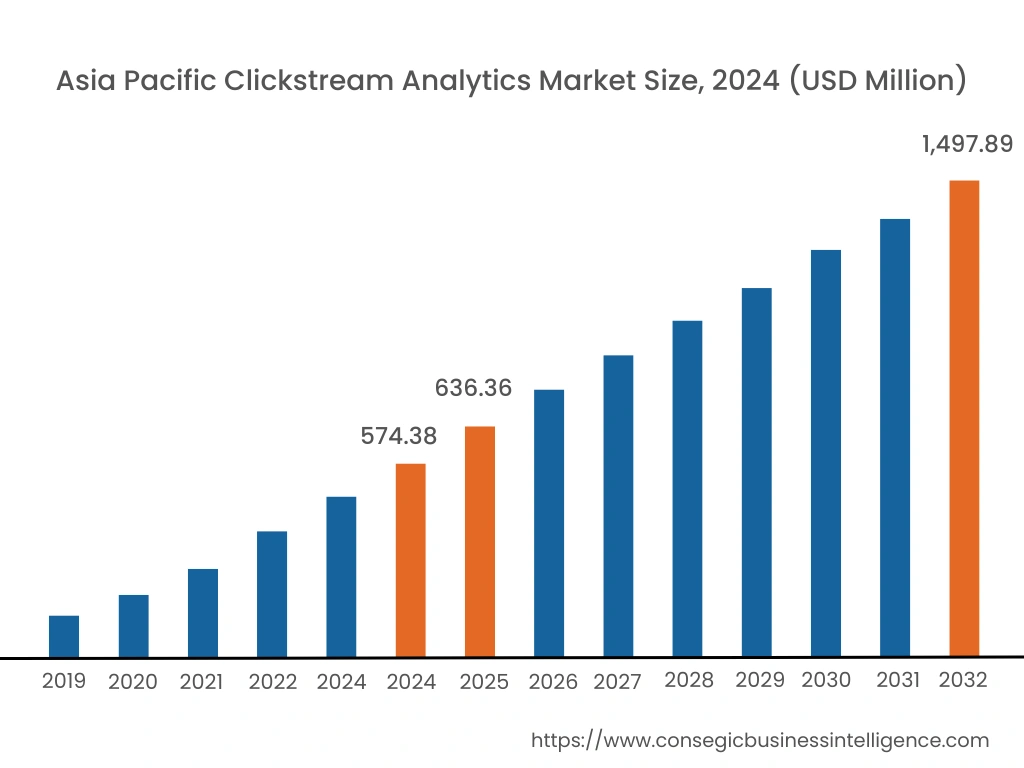
Asia Pacific region was valued at USD 574.38 million in 2024. Moreover, it is projected to grow by USD 636.36 Million in 2025 and reach over USD 1,497.89 Million by 2032. Out of these, China accounted for the largest share at 32.9% in 2024. Asia-Pacific is witnessing the fastest growth in the clickstream analytics market, driven by increasing internet penetration, rapid urbanization, and the extension of the e-commerce sector in countries like China, Japan, and India. The region has become a global hub for digital innovation, with a strong emphasis on enhancing customer engagement and optimizing online platforms. The growing demand for real-time analytics and the need to understand diverse consumer behaviors contribute to market progress.
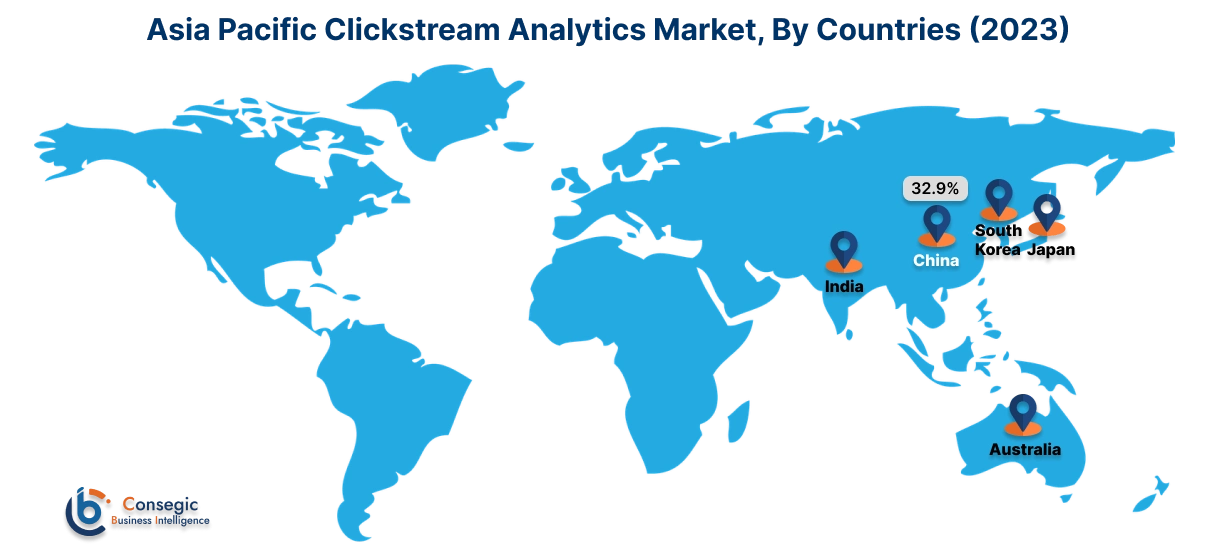
North America is estimated to reach over USD 1,594.31 Million by 2032 from a value of USD 646.93 Million in 2024 and is projected to grow by USD 713.35 Million in 2025. This region holds a substantial share of the clickstream analytics market, primarily due to a well-established digital infrastructure and early adoption of advanced analytics solutions. The United States, in particular, has a significant market presence, with major enterprises investing heavily in analytics to gain insights into customer behavior and optimize online experiences. The need for personalized marketing strategies and the integration of big data analytics propel market development.
Europe represents a significant portion of the global clickstream analytics market, with countries like Germany, the UK, and France leading in terms of adoption and innovation. The region benefits from strong government support for digital transformation initiatives and a robust industrial base. The focus on enhancing customer experience and the integration of analytics in e-commerce platforms further accelerates the adoption of clickstream analytics solutions.
The Middle East & Africa region shows promising potential in the clickstream analytics market, particularly in countries like the UAE, Saudi Arabia, and South Africa. Increasing investments in digital infrastructure, a growing e-commerce market, and government initiatives to promote technological adoption drive the need for clickstream analytics solutions. The expanding tourism sector and the adoption of smart technologies further support market development.
Latin America is an emerging market for clickstream analytics, with Brazil and Mexico being the primary growth drivers. The rising adoption of digital technologies, improving industrialization, and increasing focus on enhancing customer experience contribute to the market's development. Government initiatives aimed at modernizing digital infrastructure and promoting foreign investments support market progression.
Top Key Players & Market Share Insights:
The clickstream analytics market is highly competitive with major players providing products and services to the national and international markets. Key players are adopting several strategies in research and development (R&D), product innovation, and end-user launches to hold a strong position in the global clickstream analytics market. Key players in the Clickstream Analytics industry include –
- Adobe Systems Incorporated (USA)
- Oracle Corporation (USA)
- Google LLC (USA)
- IBM Corporation (USA)
- Microsoft Corporation (USA)
- SAP SE (Germany)
- Connexity Inc. (USA)
- Hewlett Packard Enterprise (USA)
- Jumpshot Inc. (USA)
- Splunk Inc. (USA)
Recent Industry Developments :
Product Launches:
- In October 2024, Yext introduced Review Generation, a solution designed to help businesses manage and enhance their online reputation. The tool automates the collection of customer reviews across various platforms, enabling businesses to gather more feedback and improve their visibility. This solution aims to streamline the process of obtaining positive reviews, helping businesses attract new customers and strengthen trust with existing ones.
- In October 2024, Definitive Healthcare launched Market Forecast, a predictive analytics tool aimed at helping healthcare organizations prepare for future market conditions. The solution delivers market trend projections for up to 10 years, providing insights into patient demand, diagnoses, and procedures. It helps healthcare leaders plan more effectively by assessing market growth, resource allocation, and demand for service lines. The platform combines data from historical claims and U.S. Census population data, supporting strategic planning and improving patient acquisition, retention, and overall market expansion.
- In June 2024, Alchemer launched Pulse, an AI-powered tool designed to help teams convert noisy text feedback into actionable insights. Pulse uses advanced AI to analyze customer feedback, identifying key signals that teams can act on to improve their offerings. This tool is particularly beneficial for customer-obsessed teams, providing them with valuable, real-time data for decision-making.
Product Enhancements:
- In November 2024, Amdocs introduced enhanced generative AI capabilities within its amAIz platform, integrating advanced GenAI agents to revolutionize customer engagement for communications service providers (CSPs). These agents enable real-time support for billing, sales, and personalized customer interactions. Powered by NVIDIA's AI technologies, including speech synthesis and lifelike avatars, the platform enhances automation, predictive interactions, and analytics. This integration aims to provide seamless, adaptive customer experiences, aligning with the growing demand for digital-first, always-available services.
Clickstream Analytics Market Report Insights :
| Report Attributes | Report Details |
| Study Timeline | 2019-2032 |
| Market Size in 2032 | USD 4,919.18 Million |
| CAGR (2025-2032) | 12.3% |
| By Component |
|
| By Deployment Mode |
|
| By Application |
|
| By Analysis Type |
|
| By Data Type |
|
| By Tool Type |
|
| By End-User Industry |
|
| By Region |
|
| Key Players |
|
| North America | U.S. Canada Mexico |
| Europe | U.K. Germany France Spain Italy Russia Benelux Rest of Europe |
| APAC | China South Korea Japan India Australia ASEAN Rest of Asia-Pacific |
| Middle East and Africa | GCC Turkey South Africa Rest of MEA |
| LATAM | Brazil Argentina Chile Rest of LATAM |
| Report Coverage |
|
Key Questions Answered in the Report
How big is the Clickstream Analytics market? +
Clickstream Analytics Market size is estimated to reach over USD 4,919.18 Million by 2032 from a value of USD 1,950.29 Million in 2024 and is projected to grow by USD 2,154.65 Million in 2025, growing at a CAGR of 12.3% from 2025 to 2032.
What specific segmentation details are covered in the Clickstream Analytics Market report? +
The Clickstream Analytics market report includes segmentation details for components, deployment modes, applications, analysis types, data types, tool types, and end-user industry.
Which is the fastest-growing application in the Clickstream Analytics market? +
The Click Path Optimization segment is expected to register the fastest CAGR during the forecast period, driven by its critical role in improving user experience and conversion rates. The demand for optimization tools is growing due to the increasing focus on data-driven strategies and enhanced website performance.
Who are the major players in the Clickstream Analytics Market? +
The key players in the Clickstream Analytics market include Adobe Systems Incorporated (USA), Oracle Corporation (USA), Google LLC (USA), IBM Corporation (USA), Microsoft Corporation (USA), SAP SE (Germany), Connexity Inc. (USA), Hewlett Packard Enterprise (USA), Jumpshot Inc. (USA), and Splunk Inc. (USA).
